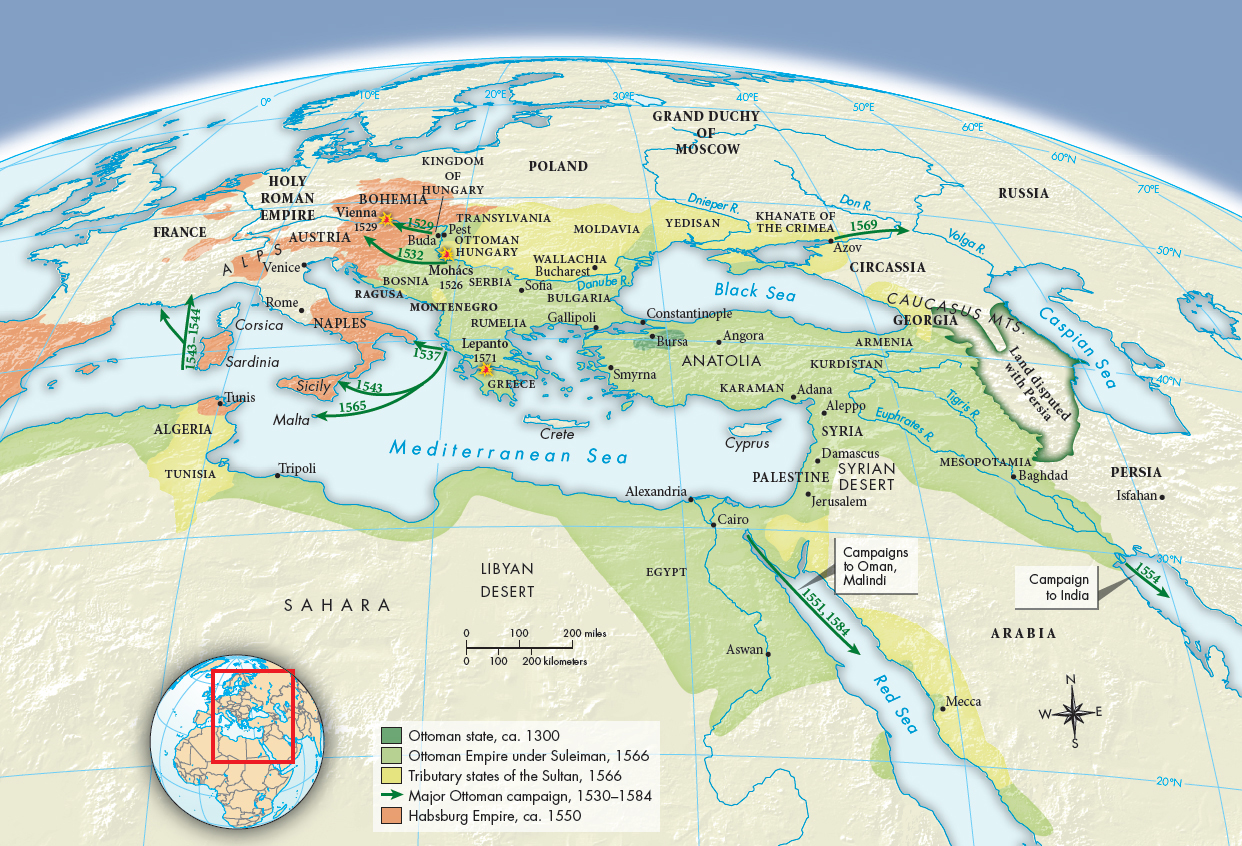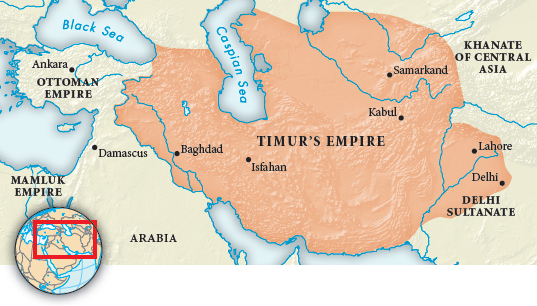Understanding World Societies:
Printed Page 487
The Ottoman Turkish Empire’s Expansion
The Ottomans took their name from Osman (r. 1299–

ANALYZING THE MAP: Trace the coastlines of the Ottoman Empire. What were the major port cities of the empire? Which regions were encompassed within the empire at its height?CONNECTIONS: If the Ottoman Empire is compared to Europe of the same period (see Map 18.2), which had more of its territory near the sea? How did proximity to the Mediterranean shape the politics of Ottoman-

Osman’s campaigns were intended to subdue, not to destroy. The Ottomans built their empire by absorbing the Muslims of Anatolia and by becoming the protector of the Orthodox Church and of the millions of Greek Christians in Anatolia and the Balkans. A series of victories between 1326 and 1352 made the Ottomans the masters of the Balkans. After these victories, the Ottomans made slaves of many captives and trained them as soldiers. These troops were outfitted with guns and artillery and trained to use them effectively.
In 1453, during the reign of Sultan Mehmet II (r. 1451–
To begin the transformation of Constantinople (renamed Istanbul) into an imperial Ottoman capital, Mehmet ordered wealthy residents to participate in building mosques, markets, fountains, baths, and other public facilities. To make up for the loss of population through war, Mehmet transplanted inhabitants of other territories to the city, granting them tax remissions and possession of empty houses. He wanted them to start businesses, make Istanbul prosperous, and transform it into a microcosm of the empire.
Gunpowder, which was invented by the Chinese and adapted to artillery use by the Europeans, played an influential role in the expansion of the Ottoman state. In the first half of the sixteenth century, thanks to the use of this technology, the Ottomans gained control of shipping in the eastern Mediterranean and eliminated the Portuguese from the Red Sea. In 1514, under the superb military leadership of Selim (r. 1512–
Suleiman (r. 1520–
Though usually victorious on land, the Ottomans did not enjoy complete dominion on the seas. Competition with the Habsburgs and pirates for control of the Mediterranean led the Ottomans to conquer Cyprus in 1570 and settle thousands of Turks from Anatolia there. In response, Pope Pius V organized a Holy League against the Turks, which won a victory in 1571 at Lepanto off the west coast of Greece. Still, the Turks remained supreme on land and quickly rebuilt their entire fleet.
To the east, war with Safavid Persia occupied the sultans’ attention throughout the sixteenth century. Several issues lay at the root of the long and exhausting conflict: religious antagonism between the Sunni Ottomans and the Shi’a Persians, competition to expand at each other’s expense in Mesopotamia, desire to control trade routes, and European alliances. (For more on the Shi’a faith, see “The Safavid Empire in Persia.”) Finally, in 1638 the Ottomans captured Baghdad, and the treaty of Kasr-
The Ottoman political system reached its classic form under Suleiman I. All authority flowed from the sultan to his public servants: provincial governors, police officers, military generals, heads of treasuries, and viziers. Suleiman ordered Lütfi Paşa (d. 1562), a poet and juridical scholar of slave origin, to draw up a new general code of laws that prescribed penalties for routine criminal acts. It also sought to reform bureaucratic and financial corruption. The legal code also introduced the idea of balanced government budgets. The head of the religious establishment was given the task of reconciling sultanic law with Islamic law. Suleiman’s legal acts influenced many legal codes, including that of the United States.
The Ottomans ruled their more distant lands, such as those in North Africa, relatively lightly. Governors of distant provinces collected taxes and maintained trade routes, but their control did not penetrate deeply into the countryside.